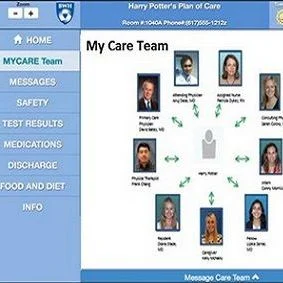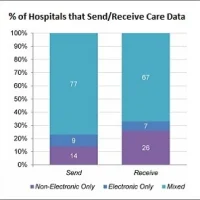New research from Brigham and Women's Hospital (Boston, MA) shows that web-based toolkits used by patients and/or their healthcare providers in the hospital setting can help increase patient engagement and improve communication with clinicians. The findings are reported in the Journal of the American Medical Informatics Association.
The study was conducted in the medical intensive care and oncology units at BWH. Researchers provided patients and their caregivers with iPads on which they could access novel tools to participate in their plan of care during hospitalisation. The patient-centred toolkit (PCTK) not only provided access to educational content specific to a patient's condition, but also facilitated patient-provider communication using a novel messaging platform integrated into providers' workflow. The researchers aimed to evaluate their enrolment strategy, use and usability of patient tools, and the content of patient-generated messages.
According to the results, non-critically ill oncology patients were more likely to engage with the PCTK compared with critically-ill medical intensive care unit (MICU) patients. However, caregivers of critically-ill MICU patients often used the PCTK on the patient's behalf. The PCTK was utilised by patients and caregivers mainly to establish goals, view test results and medications, and identify care team members.
The researchers also found that patients and caregivers used the messaging functionality primarily to report health concerns, needs, or preferences, but did not overwhelm providers with too many messages or demand immediate responses.
"Doctors and nurses oversee the plan of care, but the patients' goals, priorities, and preferences may not always be effectively conveyed to the clinical care team,” says lead author Anuj Dalal, MD, and a hospitalist in BWH's Division of General Medicine and Primary Care. “Decision-making should be shared amongst patients, families and healthcare providers. We found that this tool widened communication, helping patients and family members partner with healthcare providers to improve the quality and safety of their care.”
The BWH team notes that further studies are needed to better understand how to effectively implement this tool within complex hospital settings, including trouble shooting technological issues, and making the PCTK more user-friendly and accessible for patients and caregivers.
Source and image credit: Brigham and Women's Hospital
The study was conducted in the medical intensive care and oncology units at BWH. Researchers provided patients and their caregivers with iPads on which they could access novel tools to participate in their plan of care during hospitalisation. The patient-centred toolkit (PCTK) not only provided access to educational content specific to a patient's condition, but also facilitated patient-provider communication using a novel messaging platform integrated into providers' workflow. The researchers aimed to evaluate their enrolment strategy, use and usability of patient tools, and the content of patient-generated messages.
According to the results, non-critically ill oncology patients were more likely to engage with the PCTK compared with critically-ill medical intensive care unit (MICU) patients. However, caregivers of critically-ill MICU patients often used the PCTK on the patient's behalf. The PCTK was utilised by patients and caregivers mainly to establish goals, view test results and medications, and identify care team members.
The researchers also found that patients and caregivers used the messaging functionality primarily to report health concerns, needs, or preferences, but did not overwhelm providers with too many messages or demand immediate responses.
"Doctors and nurses oversee the plan of care, but the patients' goals, priorities, and preferences may not always be effectively conveyed to the clinical care team,” says lead author Anuj Dalal, MD, and a hospitalist in BWH's Division of General Medicine and Primary Care. “Decision-making should be shared amongst patients, families and healthcare providers. We found that this tool widened communication, helping patients and family members partner with healthcare providers to improve the quality and safety of their care.”
The BWH team notes that further studies are needed to better understand how to effectively implement this tool within complex hospital settings, including trouble shooting technological issues, and making the PCTK more user-friendly and accessible for patients and caregivers.
Source and image credit: Brigham and Women's Hospital
References:
Dalal AK et al. (2015) A web-based, patient-centered toolkit to engage patients and caregivers in the acute care setting: a preliminary evaluation. Journal of the American Medical Informatics Association,
August 03, 2015; ocv093 DOI: 10.1093/jamia/ocv093
Latest Articles
healthmanagement, health IT, web, critically ill, oncology, Brigham and Women's Hospital
New research from Brigham and Women's Hospital (Boston, MA) shows that web-based toolkits used by patients and/or their healthcare providers in the hospital setting can help increase patient engagement and improve communication with clinicians.










